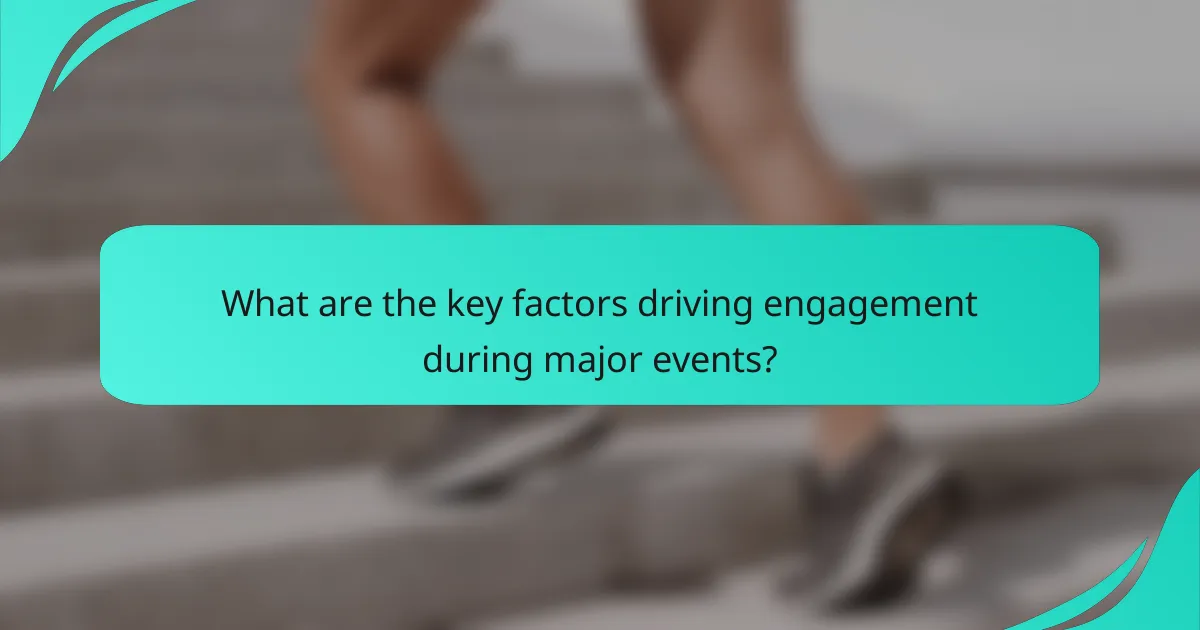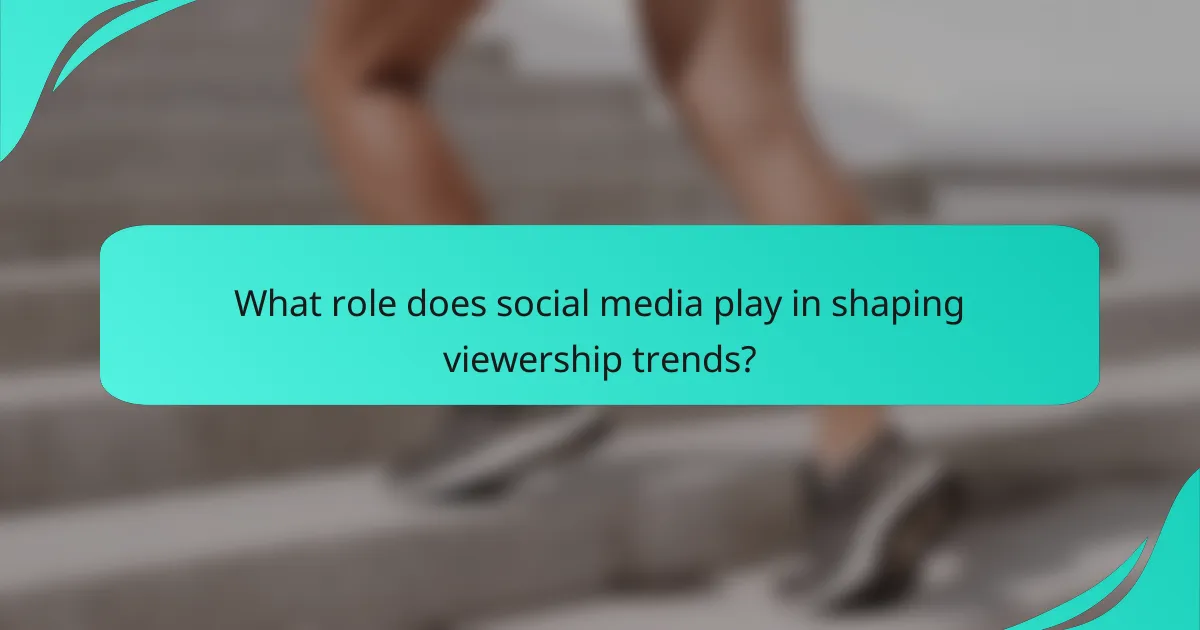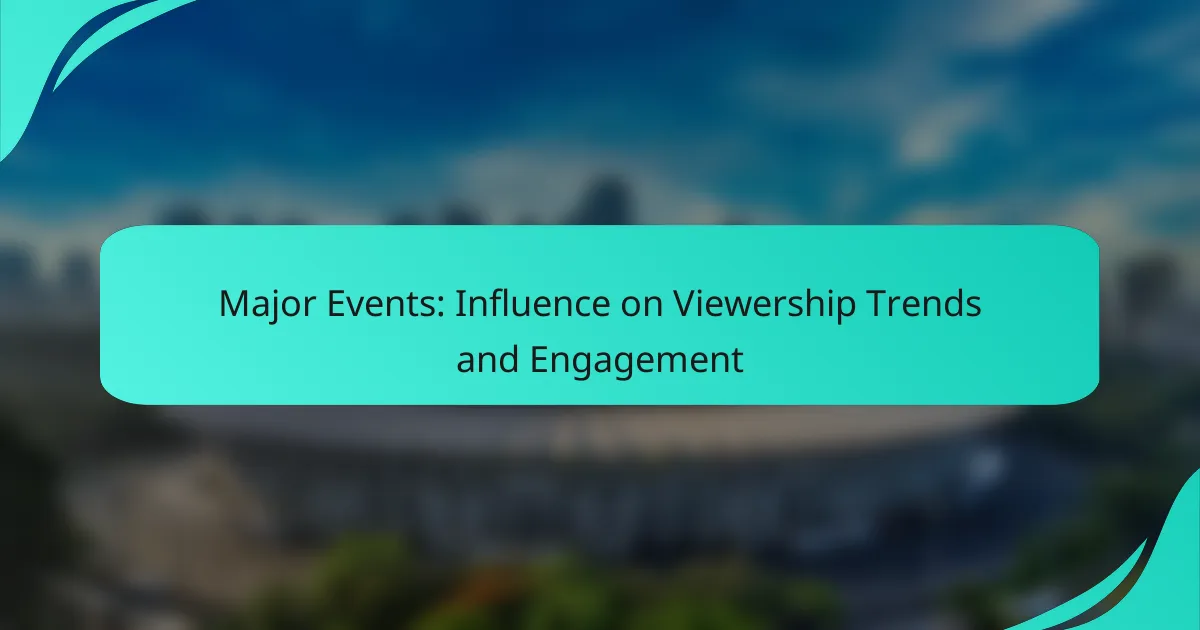Major events play a crucial role in shaping viewership trends and enhancing audience engagement across multiple platforms. They generate heightened interest, resulting in increased consumption of live broadcasts, streaming services, and social media interactions. Factors such as event timing, celebrity involvement, and interactive content significantly drive viewer participation, allowing for tailored content strategies that resonate with diverse demographics.

How do major events influence viewership trends in the United States?
Major events significantly impact viewership trends in the United States by driving increased audience engagement across various platforms. These events create a surge in interest, leading to higher consumption of live broadcasts, streaming services, and social media interactions.
Increased live streaming engagement
Major events like the Super Bowl or the Olympics lead to a notable rise in live streaming engagement. Viewers often prefer streaming services for real-time access, allowing them to watch from anywhere, whether at home or on the go.
For example, during the Super Bowl, streaming platforms can see viewership spikes of over 50% compared to regular programming. This trend highlights the importance of optimizing streaming services to handle increased traffic during such events.
Higher social media interaction
Social media interaction tends to soar during major events, with users actively discussing and sharing content related to the event. Platforms like Twitter and Instagram become hubs for real-time commentary, fan engagement, and sharing highlights.
Brands and networks often leverage this engagement by creating event-specific hashtags and interactive content, which can lead to a significant increase in followers and engagement rates. For instance, posts related to the Oscars can receive tens of thousands of interactions within minutes of airing.
Boost in advertising revenue
Major events provide a lucrative opportunity for advertisers, resulting in a boost in advertising revenue. Advertisers are willing to pay premium rates for ad slots during high-viewership events, anticipating a larger audience reach.
For example, during the Super Bowl, a 30-second ad can cost millions of dollars, reflecting the event’s massive viewership potential. Advertisers often create tailored campaigns that resonate with the event’s themes, maximizing their return on investment.

What are the key factors driving engagement during major events?
Key factors driving engagement during major events include the timing of the event, the presence of celebrities, and the use of interactive content. These elements significantly influence viewer interest and participation, enhancing the overall experience.
Event timing and scheduling
The timing and scheduling of major events can greatly impact viewer engagement. Events that are held during prime viewing hours, such as evenings or weekends, tend to attract larger audiences. Additionally, aligning events with holidays or significant cultural moments can boost interest and participation.
Consider the time zone differences when scheduling international events. For example, a live sports event broadcasted in the evening in Europe may need to be adjusted for audiences in North America to maximize viewership. Planning for these factors can enhance engagement significantly.
Celebrity appearances and performances
Celebrity appearances and performances can draw significant attention and increase viewer engagement during major events. High-profile guests or performers can create buzz, attracting fans who may not otherwise tune in. For instance, a popular music artist performing at a sports event can elevate the overall excitement and viewership.
To maximize the impact of celebrity involvement, consider promoting their participation ahead of time through social media and traditional advertising. This can create anticipation and encourage more viewers to engage with the event.
Interactive content and polls
Interactive content, such as live polls and quizzes, enhances viewer engagement by allowing audiences to participate actively. This type of content encourages viewers to express their opinions and predictions, making them feel more connected to the event. For example, polls during a live broadcast can spark discussions and keep viewers invested.
When implementing interactive features, ensure they are easily accessible across platforms, including mobile devices and social media. This accessibility can significantly increase participation rates and overall engagement during the event.

How do different types of major events affect audience demographics?
Different types of major events significantly influence audience demographics by attracting specific age groups and interests. Understanding these trends helps in tailoring content and marketing strategies to engage viewers effectively.
Sports events attract younger viewers
Sports events, such as the Super Bowl or the Olympics, typically draw a younger audience, often ranging from teens to those in their 30s. This demographic is attracted to the excitement and energy of live competitions, as well as the social aspect of watching games with friends.
To maximize engagement, brands targeting younger viewers should leverage social media platforms like Instagram and TikTok, where this audience is most active. Incorporating interactive elements, such as polls or live chats during events, can further enhance viewer involvement.
Cultural festivals engage diverse audiences
Cultural festivals, including music and art events, tend to attract a wide range of demographics, often encompassing various age groups and backgrounds. These events foster community engagement and provide a platform for cultural expression, appealing to both locals and tourists.
To effectively reach this diverse audience, organizers should consider multilingual marketing materials and inclusive programming that reflects the community’s demographics. Engaging with local influencers can also help broaden the festival’s appeal and enhance participation.
Political events draw older demographics
Political events, such as debates and rallies, generally attract older demographics, particularly those aged 40 and above. This group is often more invested in civic issues and tends to engage deeply with political content, seeking information and analysis.
For organizations aiming to engage older viewers, it is crucial to provide detailed information and facilitate discussions around key issues. Utilizing traditional media channels, such as television and print, alongside digital platforms, can effectively reach this demographic and encourage participation in political discourse.

What role does social media play in shaping viewership trends?
Social media significantly influences viewership trends by providing platforms for real-time interaction and content sharing. It allows audiences to engage with events as they unfold, shaping their viewing habits and preferences.
Real-time updates enhance engagement
Real-time updates on social media keep audiences informed and engaged during major events. Platforms like Twitter and Instagram enable users to receive instant news, commentary, and reactions, which can enhance their viewing experience.
For instance, live-tweeting during sports events or award shows creates a dynamic conversation that draws more viewers. Engaging with trending hashtags can also increase visibility and participation, encouraging more people to tune in.
Influencer partnerships drive viewership
Influencer partnerships can significantly boost viewership by leveraging the established trust and reach of popular figures. Collaborating with influencers who resonate with target audiences can attract new viewers and enhance engagement.
For example, brands often partner with social media influencers to promote live events, leading to increased interest and attendance. This strategy is particularly effective in industries like fashion and entertainment, where influencers can create buzz and excitement.
User-generated content increases reach
User-generated content (UGC) plays a crucial role in expanding reach and fostering community engagement. When audiences create and share their own content related to events, it amplifies the overall conversation and attracts more viewers.
Encouraging fans to share their experiences, photos, or opinions can create a sense of belonging and excitement. Campaigns that incentivize UGC, such as contests or challenges, can further enhance participation and visibility across social media platforms.

How can advertisers leverage major events for better engagement?
Advertisers can enhance engagement by strategically aligning their campaigns with major events that capture public attention. By creating relevant content and utilizing event-specific strategies, brands can significantly boost their visibility and interaction rates.
Targeted ad campaigns during events
Targeted ad campaigns during major events allow advertisers to reach specific audiences who are already engaged with the event. For instance, during the Super Bowl, brands can focus on demographics that are likely to watch the game, tailoring their messages to resonate with sports fans.
To maximize effectiveness, consider using data analytics to identify peak viewing times and audience interests. This can help in crafting ads that are not only timely but also contextually relevant, increasing the likelihood of viewer engagement.
Utilizing event-specific hashtags
Utilizing event-specific hashtags can significantly enhance a brand’s visibility on social media platforms. By incorporating trending hashtags related to the event, advertisers can tap into ongoing conversations and reach a broader audience interested in the event.
It’s essential to research and select hashtags that are popular yet relevant to your brand message. Engaging with users who use these hashtags can also foster community interaction and strengthen brand loyalty. Avoid using overly generic hashtags, as they may dilute your message amidst the noise.
